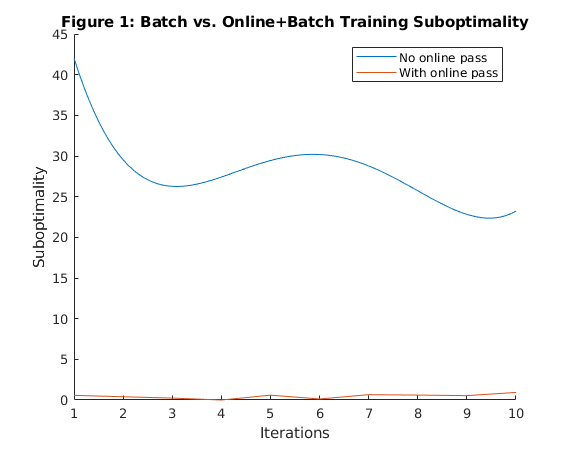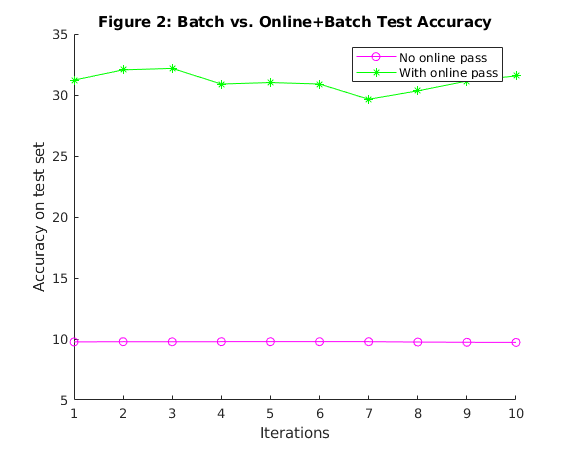Reliable Effective Linear Learning
Project by Edward Chao (ID: 20474367), Prarthana Bhattacharyya (ID: 20714026) and Hari Govind V.K. (ID : 20743574).
Based on paper by Agarwal et al [1].
Contents
Problem Formulation
Much of the work in machine learning focuses on linear learning problems of the form:

where  is the feature vector of the
is the feature vector of the  -th example,
-th example,  is the label,
is the label,  is the linear predictor,
is the linear predictor,  is a loss function and
is a loss function and  is a regularizer.
is a regularizer.
In order to optimize the objective function above when the number of examples  is too large, pure online or pure batch learning algorithms have some drawbacks. For instance, although online learning algorithms optimize the objective to a rough precision quite fast, in just a handful of passes through the data, the inherent sequential nature of these algorithms makes them tricky to parallelize. Batch learning algorithms on the other hand are great at optimizing the objective to a high accuracy, once they are in a good neighbourhood of the optimal solution, but are quite slow in reaching this good neighbourhood. This paper thus proposes to use a hybrid online + batch algorithm with rapid convergence and small synchronization overhead for their parallel learning problem with large datasets.
is too large, pure online or pure batch learning algorithms have some drawbacks. For instance, although online learning algorithms optimize the objective to a rough precision quite fast, in just a handful of passes through the data, the inherent sequential nature of these algorithms makes them tricky to parallelize. Batch learning algorithms on the other hand are great at optimizing the objective to a high accuracy, once they are in a good neighbourhood of the optimal solution, but are quite slow in reaching this good neighbourhood. This paper thus proposes to use a hybrid online + batch algorithm with rapid convergence and small synchronization overhead for their parallel learning problem with large datasets.
Proposed Optimization Algorithm
The authors propose a hybrid online + batch algorithm as their main optimization technique for linear learning over large datasets. They make one online pass over the local data and each online pass occurs asynchronously. This helps them to get into a good neighbourhood of the optimal solution rather than recovering it to a high accuracy at the first stage. This solution for the weights  is used to initialize the batch learning algorithm with the expectation that the online stage gives it a good warmstart. This algorithm benefits from the fast initial reduction of the error provided by an online algorithm, and rapid convergence in a good neighbourhood guaranteed by quasi-Newton algorithms. In addition to the hybrid strategy, the authors also propose to evaluate repeated online learning with averaging using adaptive updates. They carry out several iterations, each of which has the following phases: (1) Pass through the entire local portion of the dataset and accumulate the result as a vector od size
is used to initialize the batch learning algorithm with the expectation that the online stage gives it a good warmstart. This algorithm benefits from the fast initial reduction of the error provided by an online algorithm, and rapid convergence in a good neighbourhood guaranteed by quasi-Newton algorithms. In addition to the hybrid strategy, the authors also propose to evaluate repeated online learning with averaging using adaptive updates. They carry out several iterations, each of which has the following phases: (1) Pass through the entire local portion of the dataset and accumulate the result as a vector od size  , i.e. the same size as the parameter vector (2) Do additional processing and updating of the parameter vector. The algorithm can be represented as follows:
, i.e. the same size as the parameter vector (2) Do additional processing and updating of the parameter vector. The algorithm can be represented as follows:
Dataset
We use the CIFAR-10 dataset for demonstrating the implementation of proposed solution. The dataset can be downloaded from https://www.cs.toronto.edu/~kriz/cifar.html.
Our Implemented Solution
This section explains our implementation of the hybrid online + batch learning algorithm for optimizing the linear machine learning objective function.
% Clear all data clc; clear all; close all; %Load CIFAR-10 data data1 = load('data_batch_1.mat'); data2 = load('data_batch_2.mat'); data3 = load('data_batch_3.mat'); data4 = load('data_batch_4.mat'); data5 = load('data_batch_5.mat'); data = cat(1,data1.data,data2.data,data3.data,data4.data,data5.data); labels = cat(1,data1.labels,data2.labels,data3.labels,data4.labels,data5.labels); test_data = load('test_batch.mat'); %Setup parameters data_length = 3072; % value of dimension of input num_classes = 10; % CIFAR 10 classes svm_buffer = 1; % loss threshold step_size = 0.001; % step size for gradient update num_iters = 10; % number of iterations to run through alpha = 0.2; % regularization parameters random_W = rand(num_classes, data_length); % initialize the weights
Pure online learning
% Timer for time taken by one online pass
tic
[online_W1, ll_online1] = onlineDescent(random_W,data_length,num_classes,svm_buffer,step_size*0.1,data,labels,alpha);
t_online = toc;
[online_W2, ll_online2] = onlineDescent(online_W1,data_length,num_classes,svm_buffer,step_size*0.1,data,labels,alpha);
Only batch learning
% Timer for time taken by the batch-update
tic
[batch_W, ll_batch, al_batch] = batchDescent(random_W,data_length,num_classes,svm_buffer,step_size,data,labels,num_iters,alpha,test_data.data,test_data.labels,0);
t_batch = toc;
Online and batch learning combined
[combined_W, ll_combined, al_combined] = batchDescent(online_W2,data_length,num_classes,svm_buffer,step_size,data,labels,num_iters,alpha,test_data.data,test_data.labels,0);
% Timer for time taken by hybrid method
tic
[combined_W_itr, ll_combined_itr, al_combined_itr] = batchDescent(online_W2,data_length,num_classes,svm_buffer,step_size,data,labels,num_iters,alpha,test_data.data,test_data.labels,1);
t_combined = toc;
Numerical Results
% Test results corr_perc_batch = 100*eval_W(batch_W, test_data.data, test_data.labels); corr_perc_online = 100*eval_W(online_W2, test_data.data, test_data.labels); corr_perc_combined = 100*eval_W(combined_W, test_data.data, test_data.labels); % Test Accuracy fprintf("Batch learning accuracy percentage: %f\n",corr_perc_batch); fprintf("Online learning accuracy percentage: %f\n",corr_perc_online); fprintf("Online + batch accuracy percentage: %f\n",corr_perc_combined); % Time taken for learning fprintf("\nTime for online pass in secs: %f\n",t_batch); fprintf("Time for batch update in secs: %f\n",t_online); fprintf("Time for online + batch learning in secs: %f\n",t_combined+t_online);
Batch learning accuracy percentage: 10.500000 Online learning accuracy percentage: 29.770000 Online + batch accuracy percentage: 31.320000 Time for online pass in secs: 0.409995 Time for batch update in secs: 30.059966 Time for online + batch learning in secs: 30.108000
Visualizing the Results
Plot the Suboptimality vs Iteration for only batch and online + batch method
figure hold on p = polyfit(1:num_iters, ll_batch-min(ll_combined), 4); p_fun = polyval(p,1:0.1:num_iters); plot (1:0.1:num_iters, p_fun) title('Figure 1: Batch vs. Online+Batch Training Suboptimality') plot(1:num_iters, ll_combined - min(ll_combined)) legend('No online pass', 'With online pass') xlabel('Iterations') ylabel('Suboptimality') hold off

Plot the Test Accuracy vs Iteration for only batch and online + batch method
figure hold on plot(al_batch .* 100, 'm-o') title('Figure 2: Batch vs. Online+Batch Test Accuracy') plot(al_combined .* 100, 'g-*') legend('No online pass', 'With online pass') xlabel('Iterations') ylabel('Accuracy on test set')

Functions implemented
Function to implement Online Learning
function [W, loss_log] = onlineDescent (initial_W,dl, nc, svmbuff, ss, data_train, label,alpha) % Arrange the inputs num_classes = nc; svm_buffer = svmbuff; step_size = ss; data = data_train; labels = label; W = initial_W; num_imgs = length(data); loss_log = zeros(1,num_imgs); % For all local data for i = 1:num_imgs % Calculate score of image i img = im2double(data(i,:)); score_i = W*img'; % Get the label of image i y = double(labels(i)); % Compute the objective function (hinge loss + regularization) tmp = score_i' - score_i(y+1) + svm_buffer; maxed = max(0,tmp); loss = sum(tmp)-svm_buffer + alpha*norm(W); loss_log(i) = loss; %Compute gradient bin_mask = find(maxed); bin_array = zeros(1,num_classes); bin_array(bin_mask) = 1; bin_array(y+1) = 0; % Parameter update gradient = bin_array' * img + alpha*2*W; W = W - step_size * gradient; end end
Function to implement Batch Learning
function [W, loss_log, acc_log] = batchDescent (initial_W, dl, nc, svmbuff, ss, data_train, label, num_iters,alpha, test_data, test_label, flag) % Arrange the inputs data_length = dl; num_classes = nc; svm_buffer = svmbuff; step_size = ss; data = data_train; labels = label; num_iterations = num_iters; W = initial_W; batch_size = 16; total_size = length(data); num_imgs = batch_size; loss_log = zeros(1,num_iterations); acc_log = zeros(1,num_iterations); %For total number of epochs for j = 1:num_iterations total_loss = 0; total_gradient = zeros(num_classes, data_length); img_num = ceil(total_size.*rand(batch_size,1)); %Calculate score of batch for k=1:length(img_num) img = im2double(data(img_num(k),:)); score_i = W*img'; %Get the label of image i y = double(labels(img_num(k))); % Compute objective tmp = score_i' - score_i(y+1) + svm_buffer; maxed = max(0,tmp); total_loss = total_loss + sum(maxed)-svm_buffer + alpha*norm(W); %Accumulate gradient bin_mask = find(maxed); bin_array = zeros(1,num_classes); bin_array(bin_mask) = 1; bin_array(y+1) = 0; total_gradient = total_gradient + bin_array' * img + alpha*2*W; end % Parameter update average_loss = total_loss / num_imgs; average_gradient = total_gradient / num_imgs; W = W - step_size * average_gradient; % Evaluate the accuracy of test data loss_log(j) = average_loss; acc_log(j) = eval_W(W, test_data, test_label); if flag == 1 && acc_log(j) > 0.3 break; end end end
Function to evaluate the accuracy of test data
function eval = eval_W(W, data, labels) % Test results data = im2double(data); test_scores = W * data'; %Find predicted classes [M, I] = max(test_scores,[],1); %Compare predicted classes to ground truth evaluation = I-(double(labels')+1); idx = evaluation==0; num_corr = sum(idx); %Calculate accuracy eval = num_corr / length(labels'); end
Analysis and Conclusions
We implemented the online + batch optimization approach proposed by [1] for reliable linear learning on large datasets. We now investigate the speed of convergence of three different learning strategies: batch, online and hybrid. We are also interested in how these algorithms maximize the test accuracy.
Figure 1 compares how fast the two learning strategies - batch with and without an initial online pass - optimize the training objective. It plots the optimality gap, defined as the difference between the current objective function and the optimal one, as a function of the number of iterations. We can see that the initial online pass helps the batch reduce the optimal value within very few iterations. Figure 2 shows the test accuracy with only batch updates and batch + online pass. The hybrid approach seems to be the most effective in terms of minimizing the test error. We also note that the hybrid method takes only a few seconds more than the purely online method but gives a higher test accuracy. We also check that this is the state of the art accuracy for linear learning on CIFAR 10.
We thus conclude that we have replicated the results shown in the paper [1]. We found that online learning is fast but since it is hard to parallelize, the parameter estimate obtained from an online pass can be used to warmstart the batch learning process. The batch learning technique converges to a very accurate estimate once it is in a good neighbourhood of the solution as shown by our experiment. Thus the hybrid online + batch method is the most effective approach and gives a more accurate solution while using up very little time overhead, allowing it to be parallelized and used for large datasets.
References
[1] Alekh Agarwal, Olivier Chapelle, Miroslav Dudik, and John Langford. A Reliable Effective Terascale Linear Learning System. Journal of Machine Learning Research, 2012. www.jmlr.org/papers/volume15/agarwal14a/agarwal14a.pdf
[2] Boyd, Stephen, and Lieven Vandenberghe. Convex Optimization. Cambridge University Press, 2004.